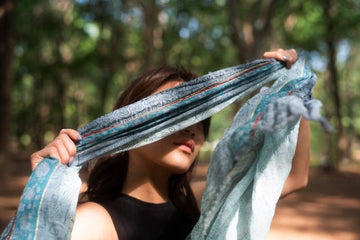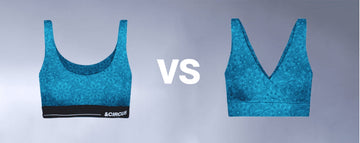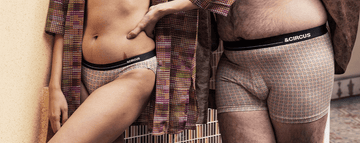Quick Listen:
In an era where the fashion world's voracious appetite for resources has long cast a shadow over its glamour, sustainable fabric blends emerge as a beacon of transformation. These ingenious combinations of fibers merging the natural resilience of hemp with the softness of organic cotton, or the recycled tenacity of polyester with biodegradable innovations aren't mere tweaks to tradition. They're a strategic pivot, reengineering apparel to minimize ecological harm while maximizing wearability. Imperatives louder than ever, brands like AndCircus are at the vanguard, infusing their inclusive loungewear and underwear lines with these blends to offer consumers guilt-free indulgence. The stakes? A industry-wide reckoning that could slash carbon footprints by prioritizing materials that perform without plundering the planet.
Uncomfortable underwear shouldn't steal your confidence. At Andcircus, we craft ultra-soft, sustainable Lenzing Modal Micro® innerwear for every body, XS to 5XL. From briefs to bras, our custom packs fit you perfectly. Shop risk-free with our 100% satisfaction guarantee and embrace comfort that includes everyone. #LoveEveryBody. Shop Now!
Defining Sustainable Fabric Blends in Today's Landscape
Sustainable fabric blends represent a deliberate fusion of diverse fibers designed to amplify desirable traits like breathability, durability, and eco-stewardship, all while curtailing environmental drawbacks. Rooted in age-old textile artistry recall the wool-silk unions of yesteryear for their opulent warmth these modern iterations respond to urgent calls for accountability. They integrate plant-derived staples such as Tencel with recycled synthetics, creating hybrids that demand less water, emit fewer toxins, and decompose more gracefully than their monolithic counterparts.
The urgency stems from fashion's outsized toll: an estimated 10% of global carbon emissions and billions of tons of textile waste annually. Yet, innovation counters this tide. For AndCircus, such blends translate into collections that cater to diverse bodies with unparalleled comfort, using bamboo viscose melded with organic cotton for that elusive silk-like drape minus the ethical quandaries. This isn't peripheral; it's pivotal. By weaving in recycled content and bio-based elements, these fabrics not only lighten the load on landfills but also enhance user experience think moisture-wicking underwear that feels like a second skin, all certified under rigorous standards.
At events like the Performance Days Trend Forum, curated by a panel of university scholars, brand executives, and fabric wizards, the spotlight falls on 100% sustainable selections. These showcase blends like Tencel-wool for baselayer softness or nylon-wool for rugged midlayers, underscoring how such pairings bolster performance in everything from trail-ready tights to urban loungewear. The result? Apparel that endures seasons, not trends, fostering a wardrobe ethos where sustainability fuels, rather than fetters, style.
Emerging Trends and Breakthrough Developments
The horizon for sustainable fabric blends brims with momentum, propelled by a confluence of technological leaps and market pressures. Foremost among these is the surge in blended materials optimized for dual realms: the casual comfort of daily wear and the rigors of performance gear. Consider organic cotton intertwined with hemp a duo that slashes water usage by up to 50% in cultivation while delivering breathable fortitude ideal for loungewear. Or Tencel, derived from sustainably sourced eucalyptus, paired with organic wool for midlayer magic: insulating yet lightweight, perfect for transitional pieces that layer seamlessly.
Recycled polyester fused with biodegradable fibers takes this further, yielding activewear that withstands sweat sessions without shedding microplastics into waterways. These aren't hypotheticals; they're staples in collections from niche innovators to mass-market shifters, particularly in underwear and loungewear where skin contact demands gentleness alongside grit.
Parallel to material alchemy, textile waste reduction via upcycling commands attention. Fabrics born from post-consumer detritus discarded bottles morphing into polyester yarns, or fishing nets reborn as nylon blends embody closed-loop paradigms. At Performance Days, exemplars abound: SeaWool, a recycled polyester-wool hybrid from oyster shell waste, graces shirts with oceanic origins, while Spectra fibers from fishing nets fortify packs. Such practices loop waste back into value, with only a fraction heading to incinerators, thanks to mono-component designs that streamline reprocessing.
Enhancing these blends are eco-friendly dyes and treatments that redefine production hygiene. Low-impact, waterless dyeing employing air or CO2 as mediums curbs the 20% of global wastewater pollution traced to textiles. Chemical-free finishes, like those in brrr° cooling tech for safety-focused fabrics, promote skin health without synthetic residues. Together, they elevate blends from functional to forward-thinking, aligning with certifications like bluesign and Oeko-Tex that vet for low-impact integrity. The Global Recycled Standard (GRS) dominates here, certifying the lion's share of these innovations and signaling a market tilt toward verifiable virtue.
Real-World Applications and Illuminating Case Studies
Theory meets thread in the portfolios of trailblazing brands, where sustainable blends prove their mettle in tangible triumphs. AndCircus exemplifies this ethos, embedding bamboo viscose-organic cotton amalgams into their underwear and loungewear. These compositions yield unparalleled breathability viscose's drape tempered by cotton's absorbency tailored for inclusivity across sizes and shapes. Customers rave about the buttery feel that persists through washes, a testament to enhanced longevity that curtails replacement cycles and, by extension, resource churn.
Beyond AndCircus, the sector teems with precedents. Patagonia's hemp-organic cotton blends armor their outerwear against abrasion while sipping half the water of pure cotton variants, extending garment lifespans to a decade or more. This durability fosters loyalty, as wearers invest in pieces that evolve with them. Stella McCartney, meanwhile, vows to non-toxic fibers like forest-stewarded viscose, blended judiciously to sidestep synthetic's pitfalls, yielding dresses that drape elegantly without environmental encumbrance.
Zooming out, the global sustainable fabrics market, pegged at $29.1 billion in 2023, hurtles toward $74.8 billion by 2032 at a 12.5% CAGR. Asia-Pacific, commanding 45.8% share in 2022, spearheads this via organic cotton fervor and R&D pacts Teijin Limited's recycled carbon fiber ventures with Fuji Design exemplify strategic synergies boosting presence. Such cases illuminate how blends amplify consumer delight: softer textures, truer colors post-dyeing, and ethical assurance that transmutes shopping into stewardship, cementing brand allegiance in a discerning demographic.
Navigating Key Challenges and Inherent Risks
For all their promise, sustainable fabric blends grapple with formidable friction points that demand candid reckoning. Chief among them looms cost: premium pricing for organic or recycled inputs often 20-30% steeper strains margins for brands and budgets for buyers. AndCircus navigates this by scaling efficiencies, yet the affordability-sustainability seesaw persists, potentially sidelining eco-options from mainstream access.
Supply chain snags compound the issue. Securing consistent volumes of high-caliber natural fibers like hemp or RWS-certified wool proves erratic, exacerbated by ethical sourcing labyrinths spanning continents. Volatility in raw material yields, coupled with certification audits, inflates timelines and tariffs, testing even fortified networks.
Durability trade-offs further complicate the calculus, nowhere more than in activewear where blends must defy stretch and strain. Hemp's robustness wanes against spandex's snap, while recycled polyester's variability can compromise consistency. As fiber blend challenges elucidate, cotton-polyester unions boost resilience and cost-efficiency but thwart recycling separation tech lags, consigning hybrids to landfills where they linger for centuries, leaching microplastics. Wool-silk's luxury comes at biodegradability's expense, underscoring the imperative for enzymatic breakthroughs to harmonize green intent with gridiron grit.
Seizing Opportunities and Quantifying Business Gains
Yet, these headwinds pale against the gale-force opportunities animating the sector. Millennial and Gen Z cohorts, comprising 40% of global consumers by 2025, propel demand for verdant wares, with surveys showing 70% willing to premium-pay for transparency. Fabric innovations dovetail here, offering greener solutions that resonate sustainable fabrics poised to swell from $17.6 billion in 2023 to $27.8 billion by 2029 at 8.1% CAGR, Asia-Pacific's 40% dominance fueled by manufacturing might and eco-shifts.
Circular fashion amplifies this, with blends engineered for recyclability mono-materials or disassembly-friendly designs enabling loops where end-of-life garb rebirths as new. Biodegradable additives in polyester hybrids, for instance, hasten decomposition, slashing long-term waste by 60% in pilot programs. This circular pivot not only conserves resources but curtails costs, as recycled inputs undercut virgin prices over time.
Business-wise, the dividends are unequivocal: elevated brand equity, with sustainable adopters reporting 25% loyalty lifts. Competitive moats form around innovation partnerships with material mavens yield proprietary blends that differentiate. For AndCircus, this manifests in fervent communities, where eco-credentials convert casual browsers to converts, underscoring sustainability's role as a profit engine in an awakening arena.
Expert Visions and the Horizon Ahead
Textile titans and designers converge on a bullish vista: bio-based and lab-grown fabrics will supplant synthetics, birthing blends that mimic nature's genius algae-infused nylons or mycelium-wool fusions promising zero-waste wonders. As one forum curator notes, "Certifications like Cradle to Cradle will eclipse GRS as circularity claims center stage," with just two such fabrics now hinting at exponential uptake.
The trajectory? A fashion renaissance where blends propel inclusivity and resilience, from adaptive activewear to equitable essentials. For pioneers like AndCircus, the mandate rings clear: ally with scientists and stewards to pioneer, iterate, and inspire. In this weave of progress, the thread binding us all is choice opt for blends that bind us to a brighter tomorrow.
Frequently Asked Questions
What are the main challenges facing sustainable fabric blends in 2025?
The primary challenges include premium pricing that's typically 20-30% higher than conventional fabrics, supply chain inconsistencies in securing quality natural fibers, and durability trade-offs in high-performance applications. Additionally, recycling complications arise with cotton-polyester blends due to separation technology limitations, and securing consistent volumes of certified materials like RWS wool remains difficult. Despite these challenges, the sustainable fabrics market is projected to grow from $29.1 billion in 2023 to $74.8 billion by 2032.
Which sustainable fabric blends are best for activewear and loungewear?
For activewear, recycled polyester fused with biodegradable fibers offers excellent moisture-wicking properties without shedding microplastics, while organic cotton-hemp blends provide breathable durability with significantly reduced water usage. For loungewear, bamboo viscose combined with organic cotton delivers unparalleled softness and drape, as demonstrated by brands like AndCircus in their inclusive underwear and loungewear collections. Tencel-wool blends are ideal for transitional pieces, offering lightweight insulation perfect for layering.
What are sustainable fabric blends and how do they differ from traditional fabrics?
Sustainable fabric blends are deliberate fusions of diverse fibers designed to maximize eco-friendliness while enhancing performance traits like breathability and durability. Unlike traditional fabrics, these blends integrate plant-derived materials like Tencel with recycled synthetics, using up to 50% less water in production and creating garments that decompose more gracefully than conventional textiles. They address fashion's environmental impact by reducing the industry's 10% contribution to global carbon emissions.
Disclaimer: The above helpful resources content contains personal opinions and experiences. The information provided is for general knowledge and does not constitute professional advice.
You may also be interested in: Fabric Innovations Drive Shift Toward Mixed Materials in Apparel
Uncomfortable underwear shouldn't steal your confidence. At Andcircus, we craft ultra-soft, sustainable Lenzing Micro Modal innerwear for every body, XS to 5XL. From briefs to bras, our custom packs fit you perfectly. Shop risk-free with our 100% satisfaction guarantee and embrace comfort that includes everyone. #LoveEveryBody. Shop Now!







































